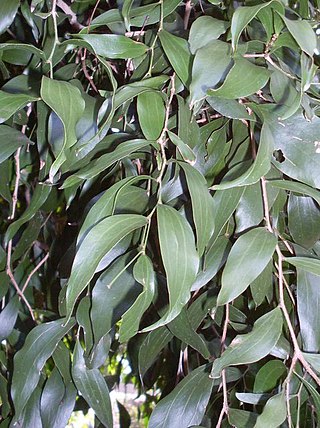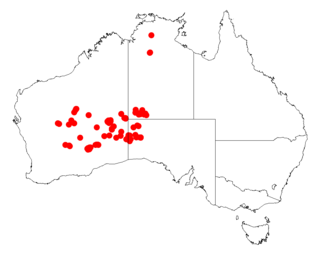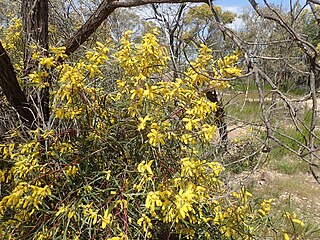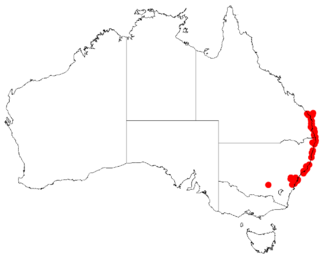
Acacia longifolia is a species of Acacia native to southeastern Australia, from the extreme southeast of Queensland, eastern New South Wales, eastern and southern Victoria, southeastern South Australia, and Tasmania. Common names for it include long-leaved wattle, acacia trinervis, aroma doble, golden wattle, coast wattle, sallow wattle and Sydney golden wattle. It is not listed as being a threatened species, and is considered invasive in Portugal, New Zealand and South Africa. In the southern region of Western Australia, it has become naturalised and has been classed as a weed by out-competing indigenous species. It is a tree that grows very quickly reaching 7–10 m in five to six years.

Acacia myrtifolia, known colloquially as myrtle wattle, red stem wattle or red-stemmed wattle, is a species of Acacia native to coastal areas of southern and eastern Australia.

Acacia bakeri, known as the marblewood, white marblewood, Baker's wattle or scrub wattle, is one of the largest of all acacias, growing to 40 m (130 ft) tall. It is a long-lived climax rainforest tree from eastern Australia. Unlike most acacias, fire is not required for seed germination. This tree is considered vulnerable to extinction. Its former habitat is lowland sub tropical rainforest which has been mostly cleared in the 19th and 20th centuries.

Acacia bynoeana, known colloquially as Bynoe's wattle or tiny wattle, is a species of Acacia native to eastern Australia. It is listed as endangered in New South Wales and as vulnerable according to the Environment Protection and Biodiversity Conservation Act 1999.

Acacia linifolia, known colloquially as white wattle, or flax wattle, is a species of Acacia native to eastern Australia.

Acacia burkittii is a species of wattle endemic to Western Australia, South Australia and western New South Wales, where it is found in arid zones, and is a perennial shrub in the family Fabaceae. Common names for it include Burkitt's wattle, fine leaf jam, gunderbluey, pin bush and sandhill wattle. It has also been introduced into India. Previously this species was referred to as Acacia acuminata subsp. burkittii, but is now considered to be a separate species. Grows in mallee, eucalypt and mulga woodland or shrubland, often on sandhills.

Acacia jibberdingensis, also known as Jibberding wattle or willow-leafed wattle, is a shrub or tree belonging to the genus Acacia and the subgenus Juliflorae that is endemic to Western Australia.

Acacia helmsiana, commonly known as Helm's wattle, is a shrub of the genus Acacia and the subgenus Plurinerves that is endemic to arid areas of central and western Australia.

Acacia trineura, known colloquially as three-nerve wattle or three nerved wattle or green wattle, is a species of Acacia native to south eastern Australia.

Acacia falciformis, also commonly known as broad-leaved hickory, hickory wattle, mountain hickory, large-leaf wattle, tanning wattle and black wattle, is a shrub belonging to the genus Acacia and the subgenus Phyllodineae that is endemic to eastern Australia

Acacia juncifolia, commonly known as rush-leaf wattle, is a shrub or tree belonging to the genus Acacia and the subgenus Phyllodineae that is endemic to north eastern Australia.

Acacia obtusata, commonly known as blunt-leaf wattle or obtuse wattle, is a tree or shrub belonging to the genus Acacia and the subgenus Phyllodineae native to eastern Australia.

Acacia pilligaensis, commonly known as Pillaga wattle or pinbush wattle, is a tree or shrub belonging to the genus Acacia and the subgenus Phyllodineae native to eastern Australia.

Acacia simmonsiana, commonly known as Simmons wattle or desert manna wattle, is a shrub belonging to the genus Acacia and the subgenus Phyllodineae native to south eastern Australia.

Acacia kettlewelliae, commonly known as buffalo wattle, is a tree or shrub of the genus Acacia and the subgenus Phyllodineae that is endemic to south eastern Australia.

Acacia microcarpa, commonly known as manna wattle, is a shrub belonging to the genus Acacia and the subgenus Phyllodineae endemic to south eastern Australia.

Acacia caroleae, also known as Carol's wattle or narrow leaf currawong, is a shrub belonging to the genus Acacia and the subgenus Juliflorae that is native to north eastern Australia.

Acacia doratoxylon, commonly known as currawang, lancewood, spearwood or coast myall, is a shrub or tree belonging to the genus Acacia and the subgenus Juliflorae that is native to eastern and south eastern Australia.

Acacia baueri, commonly known as tiny wattle, is a shrub belonging to the genus Acacia and the subgenus Lycopodiifoliae that is native to an area along the coast in eastern Australia.

Acacia baeuerlenii is a shrub of the genus Acacia and the subgenus Plurinerves that is endemic to a small area in eastern Australia.






















